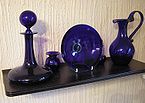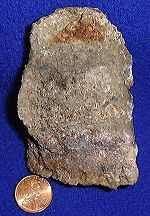Cobalt
| A user has requested that an administrator delete this page forthwith. |
| Big Speedydelete |
| See also pages that link to this page. |
| James F. Perry 14:50, 18 February 2007 (CST) |
Template:Otheruses
Template:Elementbox header
Template:Elementbox series
Template:Elementbox groupperiodblock
Template:Elementbox appearance img
Template:Elementbox atomicmass gpm
Template:Elementbox econfig
Template:Elementbox epershell
Template:Elementbox section physicalprop
Template:Elementbox density gpcm3nrt
Template:Elementbox densityliq gpcm3mp
Template:Elementbox meltingpoint
Template:Elementbox boilingpoint
Template:Elementbox heatfusion kjpmol
Template:Elementbox heatvaporiz kjpmol
Template:Elementbox heatcapacity jpmolkat25
Template:Elementbox vaporpressure katpa
Template:Elementbox section atomicprop
Template:Elementbox crystalstruct
Template:Elementbox oxistates
Template:Elementbox electroneg pauling
Template:Elementbox ionizationenergies4
Template:Elementbox atomicradius pm
Template:Elementbox atomicradiuscalc pm
Template:Elementbox covalentradius pm
Template:Elementbox section miscellaneous–
Template:Elementbox eresist ohmmat20
Template:Elementbox thermalcond wpmkat300k
Template:Elementbox thermalexpansion umpmkat25
Template:Elementbox speedofsound rodmpsat20
Template:Elementbox youngsmodulus gpa
Template:Elementbox shearmodulus gpa
Template:Elementbox bulkmodulus gpa
Template:Elementbox poissonratio
Template:Elementbox mohshardness
Template:Elementbox vickershardness mpa
Template:Elementbox brinellhardness mpa
Template:Elementbox cas number
Template:Elementbox isotopes begin
Template:Elementbox isotopes decay
Template:Elementbox isotopes decay
Template:Elementbox isotopes decay
Template:Elementbox isotopes stable
Template:Elementbox isotopes decay
Template:Elementbox isotopes end
Template:Elementbox footer
Cobalt (symbol Co) is a hard, lustrous, silver-gray metal, a chemical element. It is found in various ores, and is used in the preparation of magnetic, wear-resistant, and high-strength alloys. Its compounds are used in the production of inks, paints, and varnishes.
Notable characteristics
Cobalt is ferromagnetic. The Curie temperature is of 1388 K with 1.6~1.7 Bohr magnetons per atom. It is frequently associated with nickel, and both are characteristic ingredients of meteoric iron. Mammals require small amounts of cobalt salts. Cobalt-60, an artificially produced radioactive isotope of cobalt, is an important radioactive tracer and cancer-treatment agent. Cobalt has a relative permeability two thirds that of iron. Metallic cobalt commonly presents a mixture of two crystallographic structures: hcp (Hexagonal Closest Packing) and fcc (Face-Centered Cubic) with a transition temperature hcp→fcc of 722 K.
Common oxidation states of cobalt include +2, and +3, though +1 is also seen.
Applications
- Alloys, such as:
- Superalloys, for parts in gas turbine aircraft engines.
- Corrosion- and wear-resistant alloys.
- High speed steels.
- Cemented carbides (also called hard metals) and diamond tools.
- Magnets and magnetic recording media.
- Alnico magnets.
- Catalysts for the petroleum and chemical industries.
- electroplating because of its appearance, hardness, and resistance to oxidation.
- Drying agents for paints, varnishes, and inks.
- Ground coats for porcelain enamels.
- Pigments (cobalt blue and cobalt green).
- Battery electrodes.
- Steel-belted radial tires.
- Cobalt-60 has multiple uses as a gamma ray source:
- It is used in radiotherapy.
- It is used in radiation treatment of foods for sterilization (cold pasteurization).
- It is used in industrial radiography to detect structural flaws in metal parts.
Co-60 is useful as a gamma ray source partially because it can be produced - in known quantity, and very large amounts - by simply exposing natural cobalt to neutrons in a reactor for a given time.
Use in medicine
Cobalt-60 (Co-60 or 60Co) is a radioactive metal that is used in radiotherapy. It produces two gamma rays with energies of 1.17 MeV and 1.33 MeV. The 60Co source is about 2 cm in diameter and as a result produces a geometric penumbra, making the edge of the radiation field fuzzy. The metal has the unfortunate habit of producing a fine dust, causing problems with radiation protection. The 60Co source is useful for about 5 years but even after this point is still very radioactive, and so cobalt machines have fallen from favor in the Western world where linacs are common.
History
Cobalt compounds have been used for centuries to impart a rich blue color to glass, glazes, and ceramics. Cobalt has been detected in Egyptian sculpture and Persian jewelry from the third millennium BC, in the ruins of Pompeii (destroyed AD 79), and in China dating from the Tang dynasty (AD 618–907) and the Ming dynasty (AD 1368–1644)[1].
Swedish chemist Georg Brandt (1694–1768) is credited with isolating cobalt sometime between 1730 and 1737. He was able to show that cobalt was the source of the blue color in glass, which previously had been attributed to the bismuth found with cobalt.
During the 19th century, cobalt blue was produced at the Norwegian Blaafarveværket (70-80 % of world production), led by the Prussian industrialist Benjamin Wegner.
In 1938, John Livingood and Glenn Seaborg discovered cobalt-60.
The word cobalt is derived from the German kobalt, from kobold meaning "goblin", a term used for the ore of cobalt by miners, who thought it worthless and who found that it was poisonous and that it polluted and degraded other mined elements, mainly due to the arsenic and sulfur also found in the ore[2].
Biological role
Cobalt in small amounts is essential to many living organisms, including humans. Having 0.13 to 0.30 mg/kg of cobalt in soils markedly improves the health of grazing animals. Cobalt is a central component of the vitamin cobalamin, or vitamin B-12.
Occurrence
Cobalt is not found as a free metal and is generally found in the form of ores. Cobalt is usually not mined alone, and tends to be produced as a by-product of nickel and copper mining activities. The main ores of cobalt are cobaltite, erythrite, glaucodot, and skutterudite. The world's major producers of cobalt are the Democratic Republic of the Congo, China, Zambia, Russia and Australia. It is also found in Finland, Azerbaijan, and Kazakhstan. It is also produced in the town of Cobalt, Ontario as a byproduct of the silver mining.
- see also Category:Cobalt minerals
Compounds
There is a wide variety of cobalt compounds. The +2 and +3 oxidation states are most prevalent, however cobalt(I) complexes are also fairly common. Cobalt(II) salts form the red-pink [Co(OH2)6]2+ complex in aqueous solution. Adding excess chloride will also change the colour from pink to blue, due to the formation of [CoCl4]2-. Cobalt oxides are antiferromagnetic at low temperature: CoO (Neel temperature 291 K) and Co3O4 (Neel temperature: 40 K).
- see also Category:Cobalt compounds
Isotopes
Naturally occurring cobalt is composed of 1 stable isotope, 59Co. 22 radioisotopes have been characterized with the most stable being 60Co with a half-life of 5.2714 years, 57Co with a half-life of 271.79 days, and 56Co with a half-life of 77.27 days, and 58Co with a half life of 70.86 days. All of the remaining radioactive isotopes have half-lifes that are less than 18 hours and the majority of these have half lives that are less than 1 second. This element also has 4 meta states, all of which have half lives less than 15 minutes.
The isotopes of cobalt range in atomic weight from 50 amu (50Co) to 73 amu (73Co). The primary decay mode before the most abundant stable isotope, 59Co, is electron capture and the primary mode after is beta decay. The primary decay products before 59Co are element 26 (iron) isotopes and the primary products after are element 28 (nickel) isotopes.
Precautions
Powdered cobalt in metal form is a fire hazard. Cobalt compounds should be handled with care due to cobalt's slight toxicity.
60Co is a powerful gamma ray emitter and exposure to it is therefore a cancer risk. Ingestion of 60Co will lead to incorporation of some cobalt into tissues, which is released very slowly. 60Co is a risk factor in a nuclear confrontation because neutron emissions will convert 59Co into this isotope. Some nuclear weapon designs could intentionally increase the amount of 60Co dispersed as nuclear fallout – this is sometimes called a dirty bomb or cobalt bomb, once predicted by a leading scientist as being capable of wiping out all life on earth. The risk in the absence of a nuclear war comes from improper handling (or theft) of medical radiotherapeutic units. Nevertheless, the gamma radiation emitted from 60Co is used to kill bacteria on fruit and vegetables thus increasing their shelf life. This process is referred to as irradiation.
External links
Template:Commons Template:Wiktionary
- National Pollutant Inventory - Cobalt fact sheet
- WebElements.com – Cobalt
- London celebrates 50 years of Cobalt-60 Radiotherapy
References
Notes
af:Kobalt ar:كوبالت ca:Cobalt cs:Kobalt da:Kobolt de:Kobalt et:Koobalt el:Κοβάλτιο es:Cobalto eo:Kobalto fr:Cobalt gl:Cobalto (elemento) ko:코발트 hy:Կոբալտ hr:Kobalt io:Kobalto id:Kobalt is:Kóbolt it:Cobalto he:קובלט ku:Kobalt la:Cobaltum lv:Kobalts lb:Kobalt lt:Kobaltas hu:Kobalt nl:Kobalt ja:コバルト no:Kobolt nn:Kobolt oc:Cobalt ug:كوبالت pl:Kobalt pt:Cobalto ro:Cobalt ru:Кобальт simple:Cobalt sk:Kobalt sl:Kobalt sr:Кобалт sh:Kobalt fi:Koboltti sv:Kobolt th:โคบอลต์ vi:Coban tg:Кобалт tr:Kobalt uk:Кобальт uz:Kobalt zh:钴


